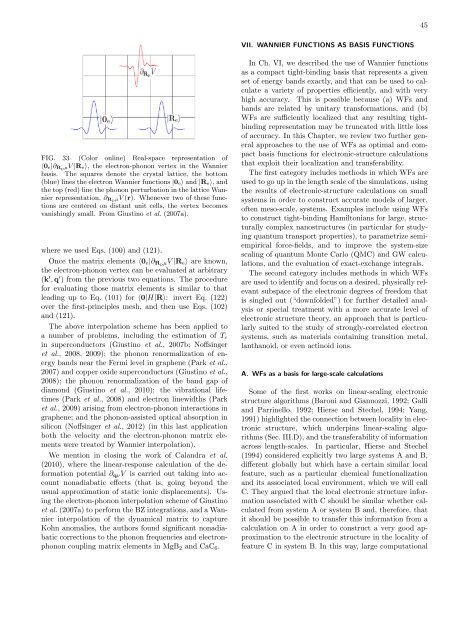Maximally localized Wannier functions: Theory and applications
Maximally localized Wannier functions: Theory and applications
Maximally localized Wannier functions: Theory and applications
Create successful ePaper yourself
Turn your PDF publications into a flip-book with our unique Google optimized e-Paper software.
45<br />
VII. WANNIER FUNCTIONS AS BASIS FUNCTIONS<br />
FIG. 33 (Color online) Real-space representation of<br />
⟨0 e|∂ Rp µV |R e⟩, the electron-phonon vertex in the <strong>Wannier</strong><br />
basis. The squares denote the crystal lattice, the bottom<br />
(blue) lines the electron <strong>Wannier</strong> <strong>functions</strong> |0 e⟩ <strong>and</strong> |R e⟩, <strong>and</strong><br />
the top (red) line the phonon perturbation in the lattice <strong>Wannier</strong><br />
representation, ∂ Rp µV (r). Whenever two of these <strong>functions</strong><br />
are centered on distant unit cells, the vertex becomes<br />
vanishingly small. From Giustino et al. (2007a).<br />
where we used Eqs. (100) <strong>and</strong> (121).<br />
Once the matrix elements ⟨0 e |∂ RpµV |R e ⟩ are known,<br />
the electron-phonon vertex can be evaluated at arbitrary<br />
(k ′ , q ′ ) from the previous two equations. The procedure<br />
for evaluating those matrix elements is similar to that<br />
leading up to Eq. (101) for ⟨0|H|R⟩: invert Eq. (122)<br />
over the first-principles mesh, <strong>and</strong> then use Eqs. (102)<br />
<strong>and</strong> (121).<br />
The above interpolation scheme has been applied to<br />
a number of problems, including the estimation of T c<br />
in superconductors (Giustino et al., 2007b; Noffsinger<br />
et al., 2008, 2009); the phonon renormalization of energy<br />
b<strong>and</strong>s near the Fermi level in graphene (Park et al.,<br />
2007) <strong>and</strong> copper oxide superconductors (Giustino et al.,<br />
2008); the phonon renormalization of the b<strong>and</strong> gap of<br />
diamond (Giustino et al., 2010); the vibrational lifetimes<br />
(Park et al., 2008) <strong>and</strong> electron linewidths (Park<br />
et al., 2009) arising from electron-phonon interactions in<br />
graphene; <strong>and</strong> the phonon-assisted optical absorption in<br />
silicon (Noffsinger et al., 2012) (in this last application<br />
both the velocity <strong>and</strong> the electron-phonon matrix elements<br />
were treated by <strong>Wannier</strong> interpolation).<br />
We mention in closing the work of Cal<strong>and</strong>ra et al.<br />
(2010), where the linear-response calculation of the deformation<br />
potential ∂ qν V is carried out taking into account<br />
nonadiabatic effects (that is, going beyond the<br />
usual approximation of static ionic displacements). Using<br />
the electron-phonon interpolation scheme of Giustino<br />
et al. (2007a) to perform the BZ integrations, <strong>and</strong> a <strong>Wannier</strong><br />
interpolation of the dynamical matrix to capture<br />
Kohn anomalies, the authors found significant nonadiabatic<br />
corrections to the phonon frequencies <strong>and</strong> electronphonon<br />
coupling matrix elements in MgB 2 <strong>and</strong> CaC 6 .<br />
In Ch. VI, we described the use of <strong>Wannier</strong> <strong>functions</strong><br />
as a compact tight-binding basis that represents a given<br />
set of energy b<strong>and</strong>s exactly, <strong>and</strong> that can be used to calculate<br />
a variety of properties efficiently, <strong>and</strong> with very<br />
high accuracy. This is possible because (a) WFs <strong>and</strong><br />
b<strong>and</strong>s are related by unitary transformations, <strong>and</strong> (b)<br />
WFs are sufficiently <strong>localized</strong> that any resulting tightbinding<br />
representation may be truncated with little loss<br />
of accuracy. In this Chapter, we review two further general<br />
approaches to the use of WFs as optimal <strong>and</strong> compact<br />
basis <strong>functions</strong> for electronic-structure calculations<br />
that exploit their localization <strong>and</strong> transferability.<br />
The first category includes methods in which WFs are<br />
used to go up in the length scale of the simulations, using<br />
the results of electronic-structure calculations on small<br />
systems in order to construct accurate models of larger,<br />
often meso-scale, systems. Examples include using WFs<br />
to construct tight-binding Hamiltonians for large, structurally<br />
complex nanostructures (in particular for studying<br />
quantum transport properties), to parametrize semiempirical<br />
force-fields, <strong>and</strong> to improve the system-size<br />
scaling of quantum Monte Carlo (QMC) <strong>and</strong> GW calculations,<br />
<strong>and</strong> the evaluation of exact-exchange integrals.<br />
The second category includes methods in which WFs<br />
are used to identify <strong>and</strong> focus on a desired, physically relevant<br />
subspace of the electronic degrees of freedom that<br />
is singled out (“downfolded”) for further detailed analysis<br />
or special treatment with a more accurate level of<br />
electronic structure theory, an approach that is particularly<br />
suited to the study of strongly-correlated electron<br />
systems, such as materials containing transition metal,<br />
lanthanoid, or even actinoid ions.<br />
A. WFs as a basis for large-scale calculations<br />
Some of the first works on linear-scaling electronic<br />
structure algorithms (Baroni <strong>and</strong> Giannozzi, 1992; Galli<br />
<strong>and</strong> Parrinello, 1992; Hierse <strong>and</strong> Stechel, 1994; Yang,<br />
1991) highlighted the connection between locality in electronic<br />
structure, which underpins linear-scaling algorithms<br />
(Sec. III.D), <strong>and</strong> the transferability of information<br />
across length-scales. In particular, Hierse <strong>and</strong> Stechel<br />
(1994) considered explicitly two large systems A <strong>and</strong> B,<br />
different globally but which have a certain similar local<br />
feature, such as a particular chemical functionalization<br />
<strong>and</strong> its associated local environment, which we will call<br />
C. They argued that the local electronic structure information<br />
associated with C should be similar whether calculated<br />
from system A or system B <strong>and</strong>, therefore, that<br />
it should be possible to transfer this information from a<br />
calculation on A in order to construct a very good approximation<br />
to the electronic structure in the locality of<br />
feature C in system B. In this way, large computational













